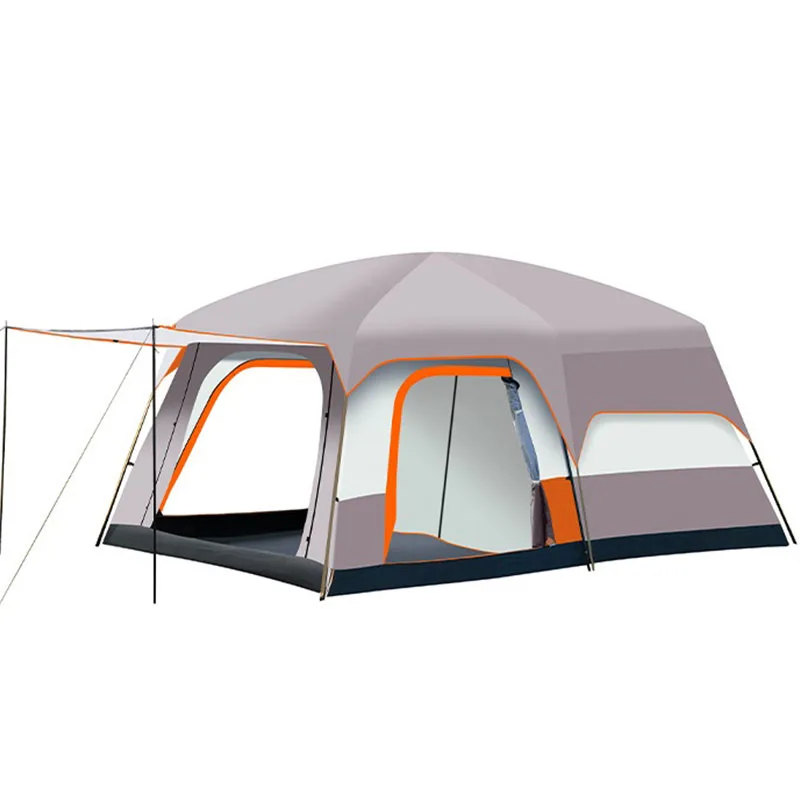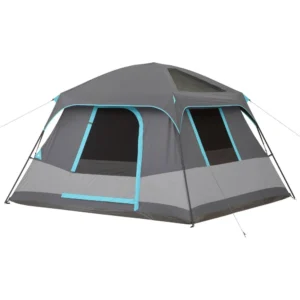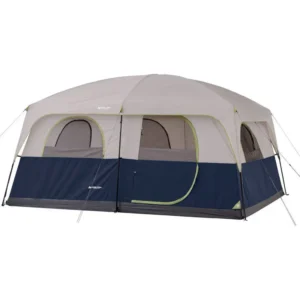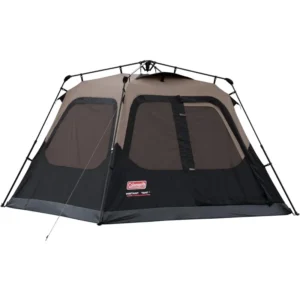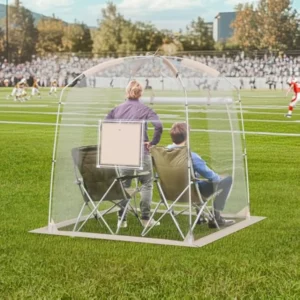Why Choose a Tall Camping Tent? Understanding the Benefits
When planning your next outdoor adventure, tent height might not be the first feature that comes to mind—but it should be. Tall camping tents, typically defined as those with peak heights of 6 feet (183 cm) or more, offer substantial advantages that can transform your camping experience from merely adequate to genuinely comfortable.
The practical benefits of standing-height tents are immediately apparent once you’ve experienced them:
- Freedom of movement: Stand upright to change clothes without the awkward crouch-and-wiggle dance typical in standard tents
- Improved comfort for extended stays: Move around naturally during longer camping trips, reducing physical strain
- Enhanced air circulation: Taller spaces allow for better ventilation, reducing stuffiness and condensation
- Reduced claustrophobia: More headroom creates a psychologically more comfortable space, especially during bad weather when you’re tent-bound
Beyond these practical advantages, the psychological benefits shouldn’t be overlooked. The ability to stand up straight affects your entire camping mindset. Many campers report feeling more relaxed and “at home” when they can move naturally within their temporary shelter. This comfort becomes particularly important during shelter options for two campers or family groups where maintaining personal space matters.
Tall tents make the most sense for car camping, family trips, and basecamp scenarios where the extra weight and bulk are easily transported. While backpackers might prioritize other features, anyone staying at a single site for multiple days will appreciate the luxury of standing height. Understanding how tall a tent should be for standing helps match your specific needs to the right tent design.
Key Dimensions: What Makes a Tent “Tall” in Practice
When evaluating tall tents, peak height is just the beginning. A tent marketed as having a 6‘6” (198 cm) center height won’t necessarily provide that much standing room throughout the shelter.
Peak height refers to the maximum interior height, typically measured at the center point. However, what truly defines a tent’s usability is the combination of:
- Peak height measurement: The highest point inside the tent
- Wall design: How quickly the walls slope away from that peak
- Usable standing area: The actual floor space where you can stand upright
Different tent designs create dramatically different interior experiences:
| Tent Style | Peak Height Characteristics | Standing Area |
|---|---|---|
| Cabin | Near-vertical walls maximize usable height throughout | 70-90% of floor area |
| Dome | Gradual slope from center peak | 20-30% of floor area |
| Tunnel/Hybrid | Extended height along central ridge | 40-60% of floor area |
Wall angle dramatically impacts the livable space. Cabin-style tents with near-vertical walls provide the most consistent headroom, while traditional dome tents may offer standing height only at the center. Some manufacturers have begun incorporating benefits of high ceiling tents into hybrid designs that balance stability with increased interior volume.
The relationship between floor dimensions and peak height is crucial—a tall but narrow tent might allow standing but restrict movement, while a wider footprint enables comfortable navigation through the space.
Critical Feature #1: Height & Interior Space Design
When comparing tall tents, understanding the nuances of interior space design reveals why two tents with identical peak heights can feel dramatically different once set up.
Peak height measurements are straightforward—the distance from the floor to the highest point inside—but this single number doesn’t tell the whole story. The real differentiator is how the tent’s architecture distributes that height throughout the structure:
- Wall steepness: Cabin-style tents with walls approaching 80-90 degrees provide standing height almost to the edges
- Pole configuration: Hub-and-pole designs with additional crossing points create more defined interior structure
- Ceiling topography: Flat-topped designs (like some cabin tents) versus curved domes affect headroom consistency
- Center height vs. edge height: Some models maintain 5’+ (152+ cm) height even near walls
- Corner design: Reinforced corners can allow more vertical walls without sacrificing stability
Innovative pole structures have revolutionized interior volume in modern tall tents. For example, some brands incorporate hub systems where multiple poles connect at key junction points, creating more box-like interiors rather than traditional domes. This structural approach maintains strength while dramatically increasing usable space.
For the most spacious options, browse our collection of tall stand-up camping tents featuring designs specifically engineered to maximize standing room. When evaluating interior space, remember that head clearance matters most in areas where you’ll be performing activities like changing clothes or organizing gear.
Critical Feature #2: Tent Capacity vs. Realistic Standing Room
Manufacturer capacity ratings often reflect how many sleeping bags can fit side by side on the floor—not how many people can comfortably move around standing up. This disconnect between capacity and comfortable living space creates confusion for many tent buyers.
When evaluating tall tents for actual use, consider implementing the “size up rule”: for comfortable standing room, choose a tent rated for approximately 2 more people than will actually be sleeping in it. This ensures adequate space for both sleeping and standing activities. Understanding what size tent is good for 2 people in practical terms often means selecting a 4-person model for true comfort.
Space considerations become even more important for taller campers (6’+ or 183+ cm), who need not just vertical height but adequate floor space to move around without constantly ducking under the lowest sections. Consider these space allocation guidelines:
- For sleeping only: 20-25 square feet (1.9-2.3 square meters) per person
- For comfortable living: 30-35 square feet (2.8-3.3 square meters) per person
- For tall campers: Add 5-10 additional square feet (0.5-0.9 square meters) per person
When camping furniture enters the equation—cots, chairs, tables, storage containers—the space requirements increase further. A family of four might need a “6-person” or even “8-person” tent to accommodate both sleeping and living areas with standing room.
Critical Feature #3: Tent Types Optimized for Height
Different tent designs offer varying advantages for campers prioritizing interior height. Each structure type balances standing room against other considerations like stability, weight, and weather resistance.
Cabin Tents
Pros:
– Maximum interior volume with near-vertical walls
– Consistent height throughout most of the interior
– Often include room dividers and multiple doors
– Excellent for long-term camping
Cons:
– Heavier than other designs
– More susceptible to wind pressure due to flat surfaces
– Typically require more time to set up
– Larger packed size
Tunnel Tents
Pros:
– Good height along central spine
– Efficient space-to-weight ratio
– Better wind resistance than cabin styles when properly oriented
– Usually lighter than cabin tents of similar size
Cons:
– Standing height limited to center area
– Require more staking and guy lines for stability
– Less freestanding than dome designs
Extended-Height Dome Tents
Pros:
– Balance of height and stability
– Generally good wind resistance
– Typically easier setup with fewer poles
– More freestanding than tunnel designs
Cons:
– Standing height primarily in center only
– Sloped walls reduce usable space
– Less efficient for multiple-room configurations
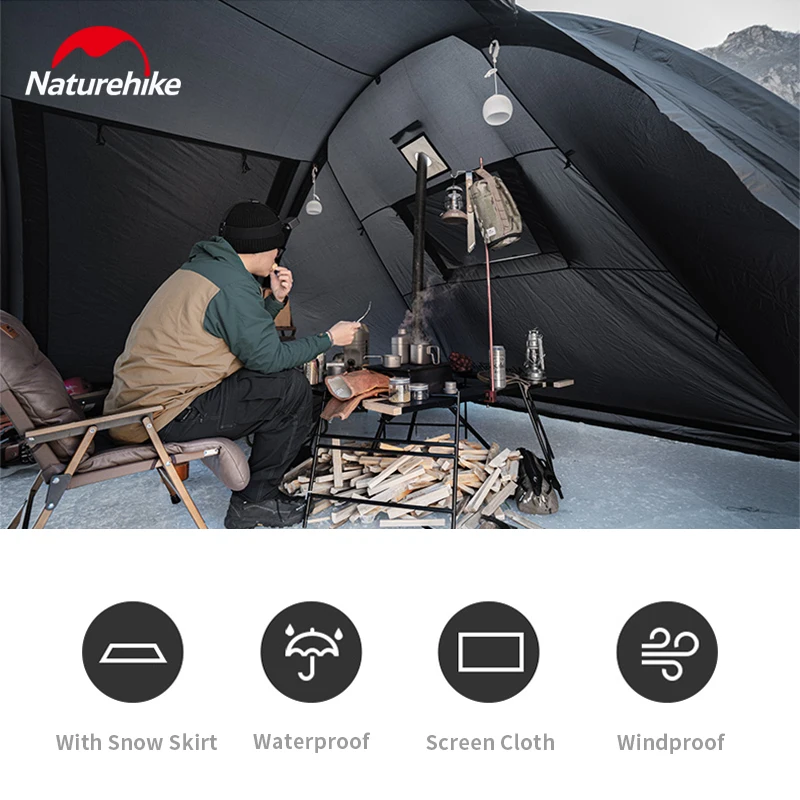
Bell/Tipi Tents
Pros:
– Excellent center height
– Traditional aesthetic appeal
– Good ventilation options
– Often suitable for wood stove use
Cons:
– Dramatically reduced space near edges
– Typically single-room design
– Center pole can obstruct movement
– More complex weather management
Inflatable Tents
Pros:
– Innovative designs often incorporate vertical walls
– Quick setup without traditional poles
– Increasingly competitive stability ratings
– Good height-to-weight possibilities
Cons:
– Higher cost for comparable quality
– Potential for punctures or air leaks
– May require access to pumps or power
For families or groups requiring distinct spaces, two-room camping tents combine standing height with practical room division. These designs allow for separate sleeping and living areas or privacy between different groups while maintaining comfortable headroom throughout.
Critical Feature #4: Materials & Durability Considerations
The materials used in tall tents require special consideration because their larger surface areas and extended structures face unique stresses. Understanding fabric and structural components helps evaluate long-term durability and performance.
Fabric Materials
Polyester:
– Superior UV resistance prevents degradation over time
– Minimal sagging when wet, maintaining tension in rainfly
– Typically 68-75 denier for walls, 150+ denier for floors in quality tents
– Less elastic than nylon, maintaining shape better in larger structures
Nylon:
– Higher strength-to-weight ratio allows lighter designs
– Greater natural elasticity can help absorb wind stress
– Often silicone-treated (silnylon) for enhanced waterproofing
– Typically needs higher denier ratings for equivalent durability
Canvas/Polycotton:
– Exceptional durability for long-term use
– Superior breathability reducing condensation
– Natural insulation properties for temperature regulation
– Significant weight penalties but excellent for semi-permanent setups
Structural Components
Aluminum Poles:
– Higher strength-to-weight ratio than fiberglass
– 7000-series aluminum offers superior strength for tall tent support
– Less likely to splinter or permanently bend under stress
– More resistant to wind and snow loading
Steel Poles:
– Maximum stability for large cabin-style shelters
– Often used in hybrid systems (steel uprights with fiberglass roof supports)
– Essential for semi-permanent or outfitter-style tall tents
– Significant weight increase but unmatched stability
Fiberglass Poles:
– Common in budget options
– Adequate for occasional fair-weather use
– Less durable in high-wind situations
– May require replacement sooner than metal alternatives
Quality indicators become especially important in tall tents where component failure is more problematic. Look for YKK zippers, reinforced stress points at pole insertion areas, double-stitched seams, and welded floor corners—all particularly crucial for tall tents for car camping where space and comfort are priorities.
Critical Feature #5: Weather Performance & Protection
Tall tents face unique weather challenges due to their increased surface area and higher profiles. Their performance in adverse conditions depends on several specialized design elements.
Waterproofing Considerations
Waterproofing in tall tents requires careful attention to both materials and design:
- Rainfly coverage: Complete coverage flies perform better than partial ones, especially in driving rain
- Hydrostatic head ratings: Look for minimum 1500mm for the rainfly and 3000mm+ for floors in tall tents
- Seam sealing: Factory-sealed seams prevent water intrusion at stitch lines
- Door and window design: Protected openings with adequate awnings prevent water entry
- Bathtub floor construction: Higher sidewalls on floor material prevent ground water seepage
Wind Stability Features
Tall tents have more exposure to wind and require enhanced stability measures:
- Guy line systems: Multiple attachment points distributed across the structure
- Pole structure: Additional cross-bracing and intersection points
- Aerodynamic design: Some models feature sloped sides in prevailing wind directions
- Stake quality: Stronger stakes and more anchor points than standard-height tents
- Wind-responsive ventilation: Systems that can be adjusted based on conditions
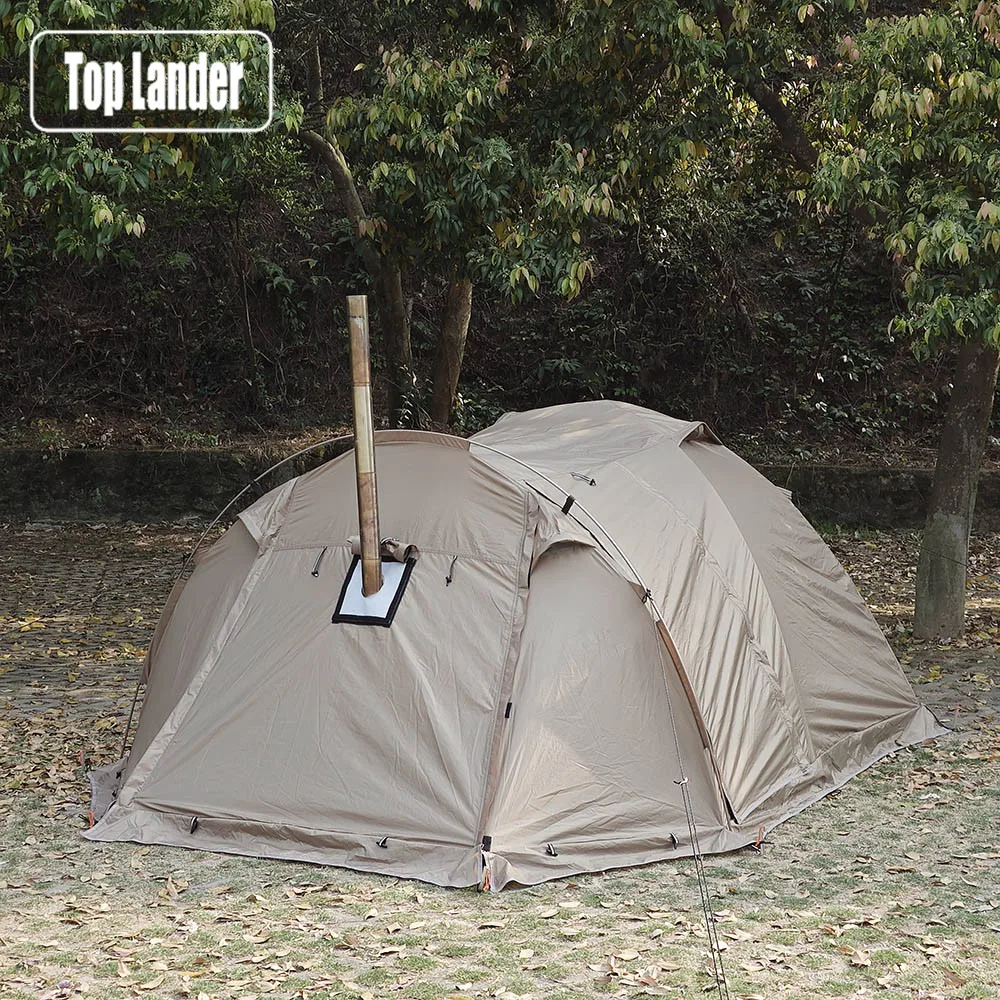
Seasonal Adaptability
Tall tents typically fall into these weather categories:
- 3-season: Focused on ventilation with substantial mesh panels and partial rainfly coverage
- 3-4 season: Balance of ventilation and weather protection with convertible features
- 4-season: Reinforced structure, minimal mesh, full-coverage rainfly for winter conditions
For camping in challenging environments, heavy duty 4 season tents provide the structural integrity needed while maintaining comfortable standing height. These designs feature stronger materials throughout and often incorporate advanced ventilation systems to prevent condensation in the larger interior space.
Proper ventilation becomes particularly critical in tall tents. Their larger interior volume can trap moisture from respiration and gear, requiring strategic airflow management through adjustable vents, mesh panels, and multiple door options.
Critical Feature #6: Setup Ease & Portability
Setting up a tall tent presents unique challenges compared to their lower-profile counterparts. Their larger size, more complex pole structures, and greater weight require specific consideration for ease of setup and transportation.
Setup Mechanisms
Different tall tent designs offer varying levels of setup convenience:
- Traditional pole-and-sleeve designs: Require methodical threading of poles through fabric sleeves
- Clip-attachment systems: Faster setup with poles assembled first, then attached via clips
- Hub-centered designs: Pre-attached poles spread from central hubs for quicker deployment
- Instant/quick-pitch frames: Pre-attached pole structures that unfold and lock into position
- Inflatable beam structures: Replace conventional poles with air-filled support beams
Most tall tents require at least two people for efficient setup, though some newer designs have attempted to address this limitation. Setup times vary dramatically, from 15-20 minutes for conventional designs to under 5 minutes for some instant or inflatable options.
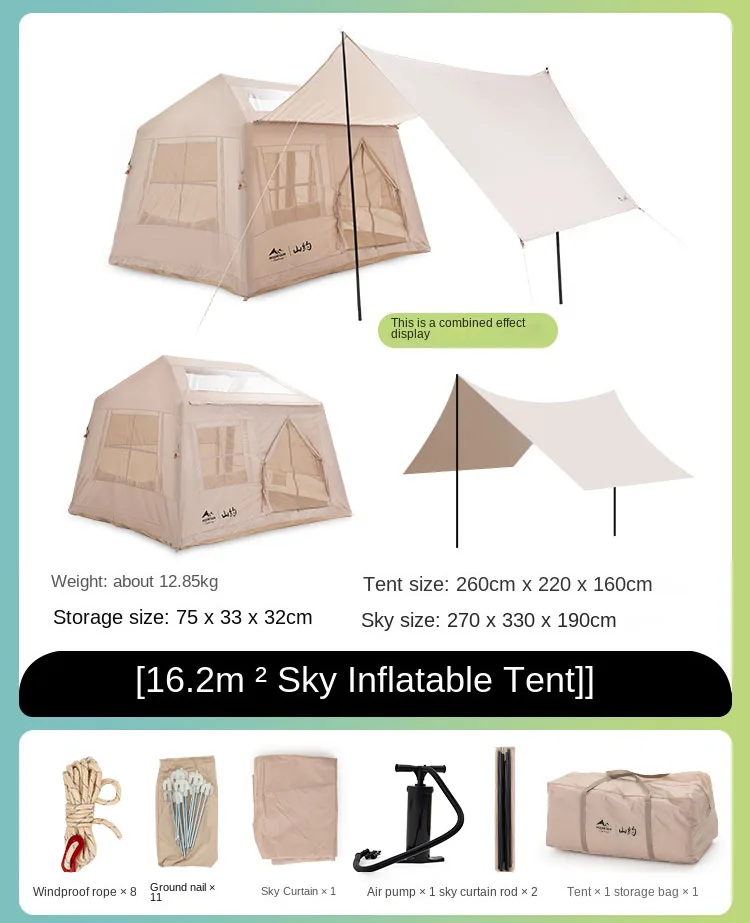
Portability Factors
The increased material and structural requirements of tall tents impact their portability:
- Weight range: Typically 15-40 pounds (6.8-18.1 kg) depending on size and materials
- Packed dimensions: Usually 24-36 inches (61-91 cm) in length, with 8-12 inch (20-30 cm) diameter
- Carrying solutions: Many include wheeled storage bags or multiple smaller component bags
- Component separation: Some models allow separate packing of rainfly, tent body, and poles
Even if you’re not backpacking, transportation and storage concerns remain relevant. Car trunk space, campsite distance from parking, and home storage all factor into the practical use of tall tents. The techniques shared in our guide to mastering two-person lightweight tent setup can also help manage larger structures more efficiently by focusing on proper sequencing and teamwork.
Critical Feature #7: Comfort & Convenience Features
The additional space in tall tents allows manufacturers to incorporate enhanced features that significantly improve the camping experience. These comfort and convenience elements often distinguish premium models from basic options.
Access and Ventilation
- Multiple doors: Allow entry/exit without disturbing others, typically with one door per “room”
- Door design: D-shaped or hinged doors provide easier access than traditional triangular openings
- Window placement: Well-positioned windows provide views and cross-ventilation
- Ceiling mesh: Stargazing panels with rainfly removed for clear night viewing
- Adjustable vents: Climate control options for different weather conditions
Interior Organization
- Gear lofts: Overhead mesh platforms for storing light items
- Hanging loops: Attachment points for lanterns, fans, or clothes lines
- Pocket systems: Specialized storage for electronics, personal items, and gear
- Built-in closets: Some larger models include designated clothing storage areas
- Cable ports: Protected openings for electrical cords when campground power is available
Space Management
- Room dividers: Privacy curtains or zip-in walls create separate spaces
- Vestibules: Protected exterior storage areas that keep gear out of living space
- Extended awnings: Covered outdoor living spaces attached to the tent
- Flooring quality: Heavier denier floors with waterproof coatings for durability
- Color-coded components: Simplify setup and orientation
These enhanced features are especially valuable in easy setup camping tents which combine standing height with user-friendly designs. The best models integrate these convenience features without compromising structural integrity or weather resistance.
Well-designed tall tents transform camping from a basic outdoor activity to a comfortable extended-stay experience. The additional interior volume allows for real living space rather than just sleeping quarters, creating a true home away from home in outdoor settings.
Top Recommended Tall Tents: Feature Comparison
After analyzing dozens of tall tent options across multiple categories, these standout models represent the best balance of height, durability, weather performance, and overall value. Each excels in specific use cases while maintaining excellent standing room.
Best Overall Tall Tent
Key Specifications:
– Peak height: 6‘6” (198 cm)
– Floor dimensions: 10’ x 10’ (3 x 3 m)
– Structure: Hub-based cabin design
– Materials: 68D polyester body, 150D polyester floor
– Weather rating: 3-season with extended coverage rainfly
– Setup time: 10-12 minutes (2 people)
– Weight: 21 lbs (9.5 kg)
– Packed size: 26” x 10” x 10” (66 x 25 x 25 cm)
Standout Features:
– Near-vertical walls provide standing height throughout 80% of interior
– Reinforced pole structure handles moderate wind and rain with ease
– Dual doors with vestibules for gear storage
– Excellent ventilation system with adjustable ground vents
– Included room divider creates flexible space options
Best For: Family camping, extended stays, campground use with vehicles
Best Budget-Friendly Option
Key Specifications:
– Peak height: 6‘2” (188 cm)
– Floor dimensions: 9’ x 7’ (2.7 x 2.1 m)
– Structure: Modified dome with extended center height
– Materials: 68D polyester with fiberglass poles
– Weather rating: 3-season with partial rainfly
– Setup time: 15 minutes (2 people)
– Weight: 16 lbs (7.3 kg)
– Packed size: 24” x 8” (61 x 20 cm)
Standout Features:
– Affordable price point without sacrificing critical height
– Large D-door for easy access
– Mesh roof panels for ventilation and stargazing
– Interior storage pockets and gear loft
– Freestanding design for easy positioning
Best For: Weekend campers, fair-weather use, those new to tall tents
Best Weather-Resistant Tall Tent
Key Specifications:
– Peak height: 6‘4” (193 cm)
– Floor dimensions: 8’ x 8’ (2.4 x 2.4 m)
– Structure: Reinforced tunnel design
– Materials: 75D polyester with aluminum poles
– Weather rating: 4-season with full-coverage rainfly
– Setup time: 15-20 minutes (2 people)
– Weight: 19 lbs (8.6 kg)
– Packed size: 27” x 9” (69 x 23 cm)
Standout Features:
– Superior wind stability with cross-braced structure
– 3000mm waterproof rating on all exterior surfaces
– Snow-shedding roof design
– Protected ventilation ports that remain functional in rain
– Heavy-duty floor with additional groundsheet included
Best For: Mountain camping, exposed sites, potential adverse weather
Best Family/Group Tall Tent
Key Specifications:
– Peak height: 6‘8” (203 cm)
– Floor dimensions: 14’ x 10’ (4.3 x 3 m)
– Structure: Multi-room cabin design
– Materials: 68D polyester with steel/fiberglass pole combination
– Weather rating: 3-season with extended eaves
– Setup time: 20 minutes (2-3 people)
– Weight: 32 lbs (14.5 kg)
– Packed size: 30” x 12” (76 x 30 cm)
Standout Features:
– Three separate rooms with removable dividers
– Multiple doors for independent access to each section
– Electrical cord port and internal cable management
– Panoramic windows with storm covers
– Extra-high ceiling throughout central living area
Best For: Large families, multi-family camping, extended stays
Tall / Stand Up Camping Tent, Two Room Camping Tent
$407.93 Select options This product has multiple variants. The options may be chosen on the product pageHeavy Duty 4 Season Tent, Mountaineering Tent, Winter Camping Tent
$870.40 Select options This product has multiple variants. The options may be chosen on the product pageHeavy Duty 4 Season Tent, Ultralight Freestanding Tent, Winter Camping Tent
$3,722.66 Select options This product has multiple variants. The options may be chosen on the product page- $476.52 Select options This product has multiple variants. The options may be chosen on the product page
Easy Setup Camping Tent, Instant Camping Tent
Instant Cabin Tent Double Layer Canvas 1-Minute Setup Spacious Family Camping Shelter with Air Vents$308.10 Select options This product has multiple variants. The options may be chosen on the product page
For traditional designs with excellent height characteristics, consider a dome camping tent with extended center poles. These strike an excellent balance between standing room and structural stability, often at a more accessible price point than specialized tall tent designs.
How to Select Your Ideal Tall Tent: Decision Framework
Finding the perfect tall tent requires matching your specific camping style and needs to the right design features. Follow this structured approach to identify your ideal tall tent:
Step 1: Assess Your Group and Usage Pattern
Start by honestly evaluating:
– Number of people regularly using the tent
– Typical trip duration (weekend vs. week-long stays)
– Activities requiring standing room (changing, game nights, rainy day activities)
– Privacy requirements (couples, families with children, mixed groups)
Step 2: Consider Your Camping Environment
Different locations demand different tent features:
– Typical weather conditions (temperature ranges, rainfall, wind exposure)
– Ground conditions (soft soil vs. rocky terrain for staking)
– Available space at preferred campgrounds
– Shade availability (affects ventilation needs)
Step 3: Evaluate Practical Limitations
Be realistic about:
– Transportation capacity (vehicle size, roof rack options)
– Storage space at home between trips
– Physical abilities of those setting up the tent
– Budget constraints and value expectations
Step 4: Prioritize Key Features
Based on your assessment, rank these features by importance:
1. Standing area size (full tent vs. center only)
2. Weather protection level
3. Setup simplicity
4. Interior organization and comfort features
5. Portability and packed size
Common trade-offs to consider include height vs. stability (taller tents generally catch more wind), standing room vs. weight, and multi-room privacy vs. setup complexity. Understanding various camping shelter options for two can provide insights into how different designs might meet your needs, even when scaling up to larger group sizes.
Frequently Asked Questions About Tall Camping Tents
What is considered a good peak height for standing inside a tent?
For comfortable standing, look for peak heights of at least 6 feet (183 cm). For taller individuals, 6‘4” (193 cm) or higher provides more comfortable clearance. Remember that usable standing space depends not just on peak height but also on wall steepness.
Are cabin tents always better than dome tents for standing room?
While cabin tents typically offer more consistent standing height throughout the interior due to their vertical walls, some modern dome tents feature extended center heights and modified pole structures that provide excellent standing space in the center area. Cabin tents excel in maximum usable space but dome tents often offer better stability in wind.
How much more do tall tents typically weigh compared to standard tents?
Tall tents generally weigh 25-50% more than their standard-height counterparts of the same capacity. This weight increase comes from additional pole material, stronger fabrics, and reinforced structural elements needed to support the larger structure. A typical 4-person tall tent might weigh 18-25 pounds (8.2-11.3 kg) compared to 12-16 pounds (5.4-7.3 kg) for a standard height version.
Can tall tents withstand strong winds effectively?
Well-designed tall tents can handle moderate wind conditions when properly set up with all guy lines deployed. However, their increased height creates more wind resistance, making them generally less stable in high winds than lower-profile designs. Look for models with additional cross-bracing, robust pole materials, and aerodynamic shapes if wind exposure is a concern.
How difficult are tall tents to set up for one person?
Most tall tents are designed for two-person setup, with larger models requiring 2-3 people for efficient installation. Solo setup is possible but challenging, particularly for cabin-style designs with separate pole assemblies. Instant or hub-based designs are more manageable for one person, though still more difficult than standard-height tents.
Are tall tents suitable for all seasons?
Tall tents are available in both 3-season and 4-season designs. The larger interior volume of tall tents can make them more difficult to heat in cold weather, but many 4-season tall models incorporate features like thicker fabrics, stronger poles, and reduced mesh to handle winter conditions effectively.
Care & Maintenance Tips for Tall Tents
Maintaining a tall tent requires special attention to several key areas:
- Thorough drying before storage: The larger surface area collects more moisture; fully extend and air dry before packing to prevent mildew
- Pole tension management: Regularly check for stress points where poles connect to fabric; release tension during extended setup
- UV protection measures: Apply fabric protectant designed for outdoor materials if your tent will experience extended sun exposure
- Zipper care: Clean and lubricate zippers more frequently as they bear additional stress in larger designs
- Seam sealing maintenance: Reapply seam sealer annually, focusing on rainfly seams and floor connections
- Strategic storage: Store loosely packed in a cool, dry place rather than tightly compressed
- Transportation protection: Use the original storage bag or a similarly protective container during transport to prevent abrasion damage
Advanced Weather Strategies for Tall Tents
Maximize your tall tent’s performance in challenging conditions with these specialized techniques:
- Directional setup: Position the lowest, most aerodynamic end toward prevailing winds
- Supplemental anchoring: Add additional guy lines to mid-height attachment points in windy conditions
- Rainfly tension adjustment: Tighten in wind, slightly loosen in rain to allow for fabric expansion
- Vestibule management: Use vestibules as windbreaks by positioning them strategically
- Ventilation control: Cross-ventilate in hot weather; in cold conditions, keep lower vents partially open but upper vents closed to maintain heat while reducing condensation
These advanced techniques help compensate for the inherent challenges of larger tent structures, allowing you to enjoy the benefits of standing height while minimizing potential drawbacks in adverse conditions.

